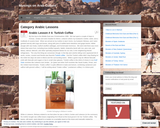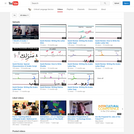
In this activity students will learn how to respond to greetings, how to greet and how to chat shortly with other persons.
- Subject:
- Arts and Humanities
- Languages
- Material Type:
- Activity/Lab
- Date Added:
- 02/25/2021

In this activity students will learn how to respond to greetings, how to greet and how to chat shortly with other persons.

In this activity students will learn how to respond to greetings, how to greet and how to chat shortly with other persons.

This blog is from an American woman living and working in Saudi Arabia. It includes information about living and working in Saudi Arabia as well as her travels elsewhere in the Middle East. This particular section of the blog includes lessons on Arabic, which are all transliterated. Conversations that are transliterated and translated, vocabulary lists, and cultural information are all included. The lessons include one on bread, one on time and the concept of time, and one on New Year's Resolutions.

In this activity, students will practice using the appropriate greeting based on the time of the day and who they are speaking to, and also will practice saying their names and asking about them.Can-Do Statements:I can greet and say goodbye to someone:In the morningIn the afternoon\evening\nightBefore bedtimeBased on who I am speaking with, I can use a culturally appropriate greeting.

In this activity, students will review how they can introduce themselves and refresh their memory with Arabic long vowels and short vowels.Can-Do Statements:I can introduce myself to others.I can recognize the Arabic alphabet and write them.I can memorize long vowels and short vowels in Arabic.

This site contains numerous audio, and video files, grouped by topic, of subjects speaking Jordanian colloquial Arabic. There are also a few images and informational links interspersed throughout the site. Each video is available for download and accompanied by an Arabic transcript and an English translation. Videos are based on every day topics like greetings, farewells, shopping, and transportation.

In this activity, students will practice asking someone they meet where they are from and their nationality. Students will start by asking each other what country they are from, and then each student will be given a country card at random. Students will then practice asking and answering questions about various nationalities.

This site houses a large number of very brief audio files in which native speakers say brief, useful, every day phrases in a number of conjugations. Phrases include things like "How much is this?" "How are you?" or simply reciting useful vocabulary and also cover numbers and time. Each phrase is spoken in 8 or 9 dialects from the regions of North Africa, the Levant, and the Persian Gulf. Every phrase is accompanied by a transcript.

In Communicating in American Culture(s), bilingual students examine how various aspects of American culture—history, geography, institutions, traditions, values—have shaped dominant Anglo-American communication norms and responses to critical events in the world. In addition, you can expect to practice and strengthen your analytical and communication skills in a carefully scaffolded manner, starting with frequent short writing and speaking tasks and progressing to longer, more formal tasks.

Critical Language Service offers playlists with video lessons that explain the material in Alif Baa, Al-Kitaab 1 (through lesson 11), and a series on Egyptian vocabulary. Videos designed for the Alif Baa series focus on stories to illustrate new vocabulary while the series designed for Al-Kitaab explains grammatical concepts introduced in the books, and demonstrate proper pronunciation. They also offer a playlist of 60 cartoon episodes in Arabic.

CultureTalk - Arab World features a very extensive selection of filmed interviews with people from different countries in the Arabic speaking world. While some interviews are in English, the vast majority are in Arabic. Translations and usually transcripts are provided for all non-English video clips. Topics include family, food, education, religious and cultural customs, work, art, sport, travel, etc. The regions covered are the Levant, North Africa, Egypt, and Mauritania, with an Iraqi section on the way.

Some students struggle with how to address people with different forms of "you" based on formality and familiarity with the person. This activity allows students to decide how they will talk to someone based on the name tag they have on. The expectation is that they will introduce themselves, then ask one or two simple questions using the correct conjugation and form of address.

Students will practice introducing themselves, greeting someone, and answering how they are doing. They will also learn greetings for different times of the day.

Students will practice introducing themselves, greeting someone, and answering how they are doing. They will also learn greetings for different times of the day. Students will understand the cultural importance of la bise, how this particular form of greeting differs in distinct areas of France, and deepen their cultural insights into how to perform a ubiquitous French greeting. Students will also learn about the geopolitical divisions in France.

Students will practice introducing themselves, greeting someone, and answering how they are doing. They will also learn greetings for different times of the day. Students will understand the cultural importance of la bise, how this particular form of greeting differs in distinct areas of France, and deepen their cultural insights into how to perform a ubiquitous French greeting. Students will also learn about the geopolitical divisions in France.

In this activity, students will have a "Meet and Greet Party." This will help them practice introducing themselves, greeting someone, and answering how they feel. They will also learn greetings for different times of the day.

Students will have a “Meet and Greet” party where they will pretend to be the person on their card, such as Heidi Klum. They will introduce themselves and greet other people, taking into account the times of the day and their feelings review the different greetings.

Students will have a “Meet and Greet” party where they will pretend to be the person on their card, such as Heidi Klum. They will introduce themselves and greet other people, taking into account the times of day and their feelings review the different greetings

I wanted students to have authentic examples of these greetings before they practice them so I added some videos of Germans greeting each other in various forms. I also wanted to add German music playing in the background just to give students a feeling of being in Germany.

Students will have a “Meet and Greet” party where they will pretend to be the person on their card, such as Heidi Klum. They will introduce themselves and greet other people, taking into account the times of the day and their feelings review the different greetings.